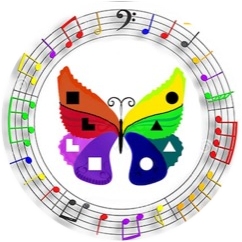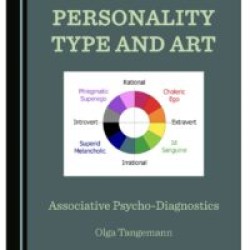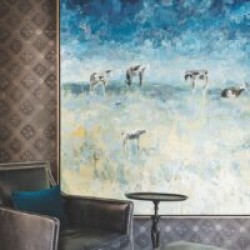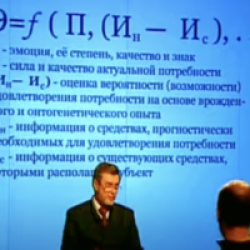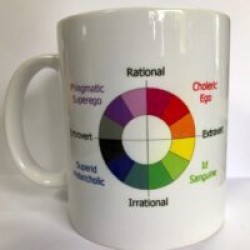1) Why do you classify as Ego-types, Id-types, Superego-types, and Superid-types what is otherwise classified as EJ temperament, EP temperament, IJ temperament and IP temperament types?
The basic 4 groups of 16 types are known as temperaments. I have rejected this name for the groups because the typology extends to understanding non-living objects which do not have a psyche or temperament and replaced it to the type of psychic energy by analogy to the type of information metabolism. Some may consider both as a metaphor.
When we type people temperament is one of the criteria and you can even ask the client to do the tests on temperament. If you type the picture you cannot do the same but it contains a type of energy associated with temperament(s).
Another reason I do not use the name of temperament – groups because we cannot always go by the criteria of temperament – there is no straightforward link between the actual temperament and the type. ILI often may show being phlegmatic, SLI sanguine, EII – melancholic and etc. The new approach has some new definitions.
The basic groups are based on 3 basic dichotomies – extraversion-introversion, rationality and irrationality, and statics- dynamics. The approach is called non-verbal, also Associative socionics and the method – associative psycho-diagnostics (APD) because it examines the preferences in the art ( paintings, photography, music, films) which require perception. However the approach is more complex and there is a lot of criteria we collect before making a final decision: analysis of non-verbal preferences ( may contain verbal comments from the client – it is allowed); results of the tests and the type -subtype analyser ( associative and other socionics tests like Talanov); video-recorded answers to the questionnaire and the feedback from the client.
The concept of types of energy is linked to the theories of S. Freud and C. Jung. to understand how you need to read the article about the associative model – it is a big article, a lot of new material. Associative theory does not contradict the basic socionics theory and uses model A but certain understanding is added which may disagree with theories of other socionics’ authors
2) Why do the tests show wrong results?
Tests are a good objective tool which must be used in combination with all other criteria because they show a general direction of thought about the type. Psyche is flexible and it is normal for people to get slightly different results at different times. Tests usually depend on how the person views himself. Associative are more ecological because some of them are fully or partly non-verbal.
However, no matter what tests you do think about the bell of the normal distribution (if you don’t know what it is – read about it).
There will be some people who will get the same results no matter what – ding at different times and even different tests. There will be people whose results will drastically different every time they do the tests. These results do not represent the tendency. The tendency is when the results change slightly but something will be stable. This something must be the focus of interest for socionics practitioner so that he can assume at least something as a high probability and see what features require his thorough attention and checking out.
The non-verbal test is like a temperament -just one of the many criteria we use. Some of the criteria may point not to the actual type but to a subtype. However, when you analyze all information together you will be able to see a general tendency, what trait is leading. There is a TPE subtype theory which you also need to discover. As I am a rational type I try to present theory logical so that it makes sense. Because we are dealing with a very complex information which combines all the very different features in the most unusual ( like art and psyche) way we must try to make a very clear and logical theory and method of diagnostics which help to prioritise and bring some order to the chaos of art which is not rational in nature.
3) How to type art?
The quick overview of how to type art you can find in this article “Criteria for assessment preferences in art through the prism of typology”.
Once you grasped the basics of the theory you study the numerous examples which you find on the website and forum. You are also welcome to my group of Socionics International to discuss it further.
I don’t understand this system of subtypes, though
It is easy to understand. First, you need to think that traits are presented as scales or graphs. When we identify type we looking what trait is less or more. Let’s say we have established the type as SLI. Now we consider that there are differences within SLIs, so we shall not consider the traits of types which are too different from SLI.
We only consider the traits of SLIs which are introversion, irrationality and dynamics and functions logics and sensing. We assume that these traits and functions may be distributed differently between SLIs and there are certain patterns of distribution.
One SLI person can be slightly more introverted than the others or slightly more extraverted and the majority will be inbetween or balanced. Some SLIs may be a bit more logical and another a bit more sensory and the majority are balanced.
However, the principal of typology is that we are not 50/50, otherwise, the typological difference simply would not exist.
So, we compare SLI on those basic dichotomies to see what trait is more and which one is less. There is variation but if you use all the criteria, test results, asks the person for a feedback and what types does the person doubt you can establish the subtype. A subtype is not overly important, it gives you a bit more detail and widens up a view of the type it is not as rigid in respect to partnership and profession, opens up more opportunities.What pattern can exist for subtype? In some person, you may see clearly what trait is dominant (most of the criteria) will point to one particular trait but you may be not sure which trait from the three is very low because two other traits are approximately the same, e.g.: introversion – dynamics/irrationality. In some other cases, you may not see which one trait stands out as 2 traits are somehow similar but you clearly see that one of the traits is very low: introversion/dynamics – irrationality.
There are cases when all three traits are very clear and you are not sure which one is to take for the subtype. In these circumstances, you look at the test results, talk to the client and let him read the description of types for psychodynamics and he can choose himself.Subtypes are only considered by the TPE – group traits ( statics- dynamics, rationality – irrationality, extraversion-introversion) and by the clubs: managers logics+ sensory; humanitarians (ethics+intuition), social worker (ethics +sensory);scientists ( logics+intuition). These means that your subtype can be within your club and within your TPE group.
If your type is SLI, you can have LSI, LSE or SLE as a subtype within your club depending….on what trait is stronger between introversion, dynamics, and irrationality. Your full subtype profile could be something like that: SLI – LSI -LSE – SLE.
If it happens that introversion is stronger and your subtype is LSI then you are logical SLI because…..the programme function of LSI is Logics Ti.
In case dynamics is stronger than introversion and irrationality mean that your subtype will be LSE who also has as a programme function Logics. This means this SLI is also logical SLI because…..the programme function of LSE is Logics Te. An only in case irrationality is stronger subtype will be SLE who has sensory as a programme function Se. In this case, we shall have sensory SLI, not logical SLI.What does it mean to be sensory or logical SLI?
It means the subtype by its’ own group will be either related to the programme or creative function. Sensory SLI will have as a subtype SEI because they share the same programme function and his logic may be not that obvious. Logical SLI will have ILI as a subtype because they share logics as creative function and his sensory is not as obvious as logic.
EII can have 3 subtypes within his club: IEE (stronger statics), EIE (stronger rationality) and IEI (stronger introversion).
EII can be ethical subtype only if rationality is stronger than statics and introversion. In two other cases, EII will be intuitive subtype and can have either IEI or IEE as a subtype.
How will this reflect on the subtype within his Superego group?
Ethical EII will have stronger ethics with intuition and sensing not being strongly polarised. Subtype will be ESI.
Intuitive EII will have intuition strongly polarised with sensing and this will make such EII closer to LII rather than ESI.
Now each of you can decide what subtype you may have and all that is left to take a test on the type of psychodynamics. If you are not sure about your subtype you can read the description of psychodynamics and this will give you an idea just choose and see if the test result will coincide with your choice of subtype.
If you decide to take the test do not forget to register to avoid the disappointment of not getting the result.
Type and subtype analyzer also will show your subtype but it is based on how well you know the meaning of the functions and how good you see your type (no need to register on the website).
– I am not using Quadras as a tool as it is much less effective – in this group you have a balance of all basic typological traits which make it much harder to understand type. The principle we use to type is to weigh out what is more and less.
Nearly all the time when I ask clients about the strong traits they give be one way or the other quadra values which are opposite in meaning and these affect their results in tests and type-subtype analyzer. People forget that we type not by what traits the person may like in others but for his strong and weak points. Quadras create a problem for type diagnostics.
What can I say about the concept of 4 dimensionalities by V. Bukalov?
I do not know if you would agree or not, but all the concepts and criteria in socionics that we use in case of diagnostics can be manifested in a situational manner, and may not be present at times. Everything has a relative value. On the one hand, it seems to be a useful concept, on the other, no. And so with many theories. Therefore, it is possible to say that some concept or method is not good at all, and sometimes I say this about the concepts openly, but even in this case, there can be 10-20% of the valuable information in that concept. It seems to me, nevertheless, that it is necessary to place priorities and it is necessary to point out the shortcomings of some concepts and tools, i.e. to show where and how they interfere.
I, too, do not use dimensionality concept of V. A.Bukalov, because the functions of the mental block in the model A are more conscious and stronger than the vital functions. BUT if you apply the idea of dimensionality exclusively to the mental block of functions and correlate the strength of functions with the dimensionalities, then this concept can be useful.
Instead of pointing to the name of the function and the degree of its strength, we say that the programme function – 4-dimensional, creative – 3 dimensions, role-normative – 2 dimensions, painful inadequate – 1 dimensionality. Even if you do not go deep into the details and do not look for the manifestation of these dimensions in detail. My opinion is that V. Bukalov made a mistake, equaling the dimensions of the mental and the vital functions because the mental and vital blocks are different in themselves according to the power of manifestation.
Am I getting tangled with Model A with your specific ID, SuperID, Ego and SuperEgo attributions?
Yes, people who first learned model A and then read about the same names applied to the small groups and associative model may get easily confused. When I write about model A I usually state it that this is about the block of model A and not about the type of energy or a small group.
I would suggest for memorising to use Freud’s structure of personality as original theory where he mentioned 3 different parts of the psyche and related them to psychic energy – conscious ( Ego and Superego )and sub -and unconscious (Id, which was devided in socionics into parts Id and Superid). This original Freud’s construct of personality as 3 energy field was later presented as a more detailed one – soionics model A for 16 types and as a more general one – associative model – typology based on 4 types of energy.
The link between the Freud’s personality construct and 4 small groups in socionics is a direct one: we have a description of Ego in Freud’s theory and we have 4 Ego-types which represent this energy as primary holders. All other 3 groups of types will have this energy as a first, second or third degree subtype/compensation.
Model A has got 4 blocks which are also linked to the Freuds construct formally but filled with different energy. Ego -energy dominates in Ego-types and is located in the Ego-block (executive block) of model A represented by the program functions. The Ego-energy dominates in the conscious ring of model A of Ego tapes represented by program and role functions.
For other types there will be a different energy to dominate in the Ego-block of model A (different program function) and in the conscious ring of model A(program+role functions).
The energy distribution in the associative model which contains only 4 types of energy will always start with the leading energy and the distribution will be graduated from strong to weak. All 4 Ego-types will start their TPE profile with Ego-energy:
Ego- Id – Superego – Superid
Ego- Superego -Id – Superid
and etc.
